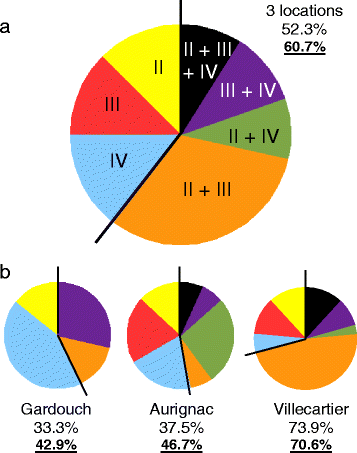Detecting and characterizing mixed infections with genetic variants of Anaplasma phagocytophilum in roe deer (Capreolus capreolus) by developing an ankA cluster-specific nested PCR
- PMID: 28784148
- PMCID: PMC5547487
- DOI: 10.1186/s13071-017-2316-0
Detecting and characterizing mixed infections with genetic variants of Anaplasma phagocytophilum in roe deer (Capreolus capreolus) by developing an ankA cluster-specific nested PCR
Abstract
Background: Anaplasma phagocytophilum is a tick-transmitted Gram-negative obligate intracellular bacterium able to infect a wide variety of wild and domestic animals worldwide. Based on the genetic diversity observed with different molecular markers, several host-specific lineages have been identified. Roe deer is one of the most important reservoirs of this bacterium and hosts different genetic groups sometimes found on domestic animals. We therefore developed an ankA cluster-specific nested PCR (nPCR) to evaluate the prevalence of the three different ankA genetic groups described in roe deer (clusters II, III and IV) at three locations in France and the level of co-infections.
Results: The specificity of the three nPCRs was assessed by partially sequencing 35 amplicons of ankA genes obtained from the different nested PCRs. All three genetic lineages were detected in roe deer from all three geographical locations. Of the infected deer population, 60.7% were co-infected by two or three different genetic variants. Co-infections varied from 42.9 to 70.6% of the infected population depending on the local infection prevalences (from 33.3 to 73.9%). All types of mixed infections occurred, suggesting the absence of a strict variant exclusion by another variant.
Conclusions: Mixed infections by two or three genetic variants of A. phagocytopilum are a common feature in roe deer. Genetic variants (cluster IV) also found in domestic ruminants (cattle and sheep) were present in all the roe deer populations analyzed, suggesting a shared epidemiological cycle.
Keywords: Anaplasma phagocytophilum; Capreolus capreolus; Co-infection; France; Nested polymerase chain reaction; Reservoir; Tick-borne diseases; ankA variant.
Conflict of interest statement
Ethics approval and consent to participate
Not applicable.
Consent for publication
Not applicable.
Competing interests
The authors declare that they have no competing interests.
Publisher’s Note
Springer Nature remains neutral with regard to jurisdictional claims in published maps and institutional affiliations.
Figures

Similar articles
-
Isolation, propagation and preliminary characterisation of Anaplasma phagocytophilum from roe deer (Capreolus capreolus) in the tick cell line IDE8.Ticks Tick Borne Dis. 2011 Dec;2(4):204-8. doi: 10.1016/j.ttbdis.2011.09.002. Epub 2011 Oct 17. Ticks Tick Borne Dis. 2011. PMID: 22108013
-
Epidemiology, genetic variants and clinical course of natural infections with Anaplasma phagocytophilum in a dairy cattle herd.Parasit Vectors. 2018 Jan 8;11(1):20. doi: 10.1186/s13071-017-2570-1. Parasit Vectors. 2018. PMID: 29310697 Free PMC article.
-
Multiple-locus variable-number tandem repeat analysis potentially reveals the existence of two groups of Anaplasma phagocytophilum circulating in cattle in France with different wild reservoirs.Parasit Vectors. 2016 Nov 22;9(1):596. doi: 10.1186/s13071-016-1888-4. Parasit Vectors. 2016. PMID: 27876073 Free PMC article.
-
[Ixodes ricinus, transmitted diseases and reservoirs].Parassitologia. 2004 Jun;46(1-2):119-22. Parassitologia. 2004. PMID: 15305699 Review. Italian.
-
Worldwide meta-analysis on Anaplasma phagocytophilum infections in animal reservoirs: Prevalence, distribution and reservoir diversity.Vet Parasitol Reg Stud Reports. 2023 Feb;38:100830. doi: 10.1016/j.vprsr.2022.100830. Epub 2022 Dec 31. Vet Parasitol Reg Stud Reports. 2023. PMID: 36725159
Cited by
-
First detection and molecular identification of the zoonotic Anaplasma capra in deer in France.PLoS One. 2019 Jul 5;14(7):e0219184. doi: 10.1371/journal.pone.0219184. eCollection 2019. PLoS One. 2019. PMID: 31276519 Free PMC article.
-
Detection of Tick-Borne Pathogens in Lambs Undergoing Prophylactic Treatment Against Ticks on Two Swedish Farms.Front Vet Sci. 2018 Apr 16;5:72. doi: 10.3389/fvets.2018.00072. eCollection 2018. Front Vet Sci. 2018. PMID: 29713635 Free PMC article.
-
A review on the eco-epidemiology and clinical management of human granulocytic anaplasmosis and its agent in Europe.Parasit Vectors. 2019 Dec 21;12(1):599. doi: 10.1186/s13071-019-3852-6. Parasit Vectors. 2019. PMID: 31864403 Free PMC article. Review.
-
Diversity of Anaplasma phagocytophilum Strains from Roe Deer (Capreolus capreolus) and Red Deer (Cervus elaphus) in Poland.Animals (Basel). 2024 Feb 16;14(4):637. doi: 10.3390/ani14040637. Animals (Basel). 2024. PMID: 38396605 Free PMC article.
-
Diverse tick-borne microorganisms identified in free-living ungulates in Slovakia.Parasit Vectors. 2018 Sep 3;11(1):495. doi: 10.1186/s13071-018-3068-1. Parasit Vectors. 2018. PMID: 30176908 Free PMC article.
References
-
- Dumler JS, Barbet AF, Bekker CP, Dasch GA, Palmer GH, Ray SC, et al. Reorganization of genera in the families Rickettsiaceae and Anaplasmataceae in the order Rickettsiales: unification of some species of Ehrlichia with Anaplasma, Cowdria with Ehrlichia and Ehrlichia with Neorickettsia, descriptions of six new species combinations and designation of Ehrlichia equi and ‘HGE agent’ as subjective synonyms of Ehrlichia phagocytophila. Int J Syst Evol Microbiol. 2001;51:2145–2165. doi: 10.1099/00207713-51-6-2145. - DOI - PubMed
-
- Rar V, Golovljova I. Anaplasma, Ehrlichia, and “Candidatus Neoehrlichia” bacteria: pathogenicity, biodiversity, and molecular genetic characteristics, a review. Infect Genet Evol. 2011;11(8):1842–61. - PubMed
MeSH terms
Substances
LinkOut - more resources
Full Text Sources
Other Literature Sources

